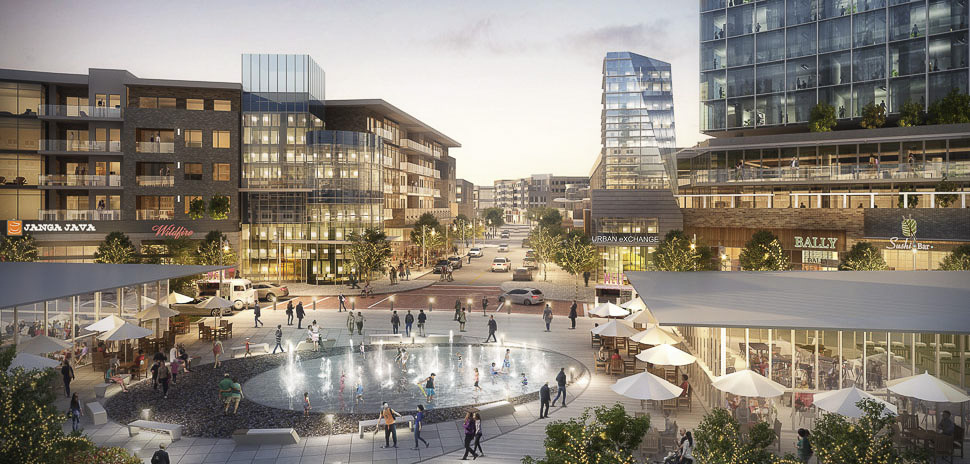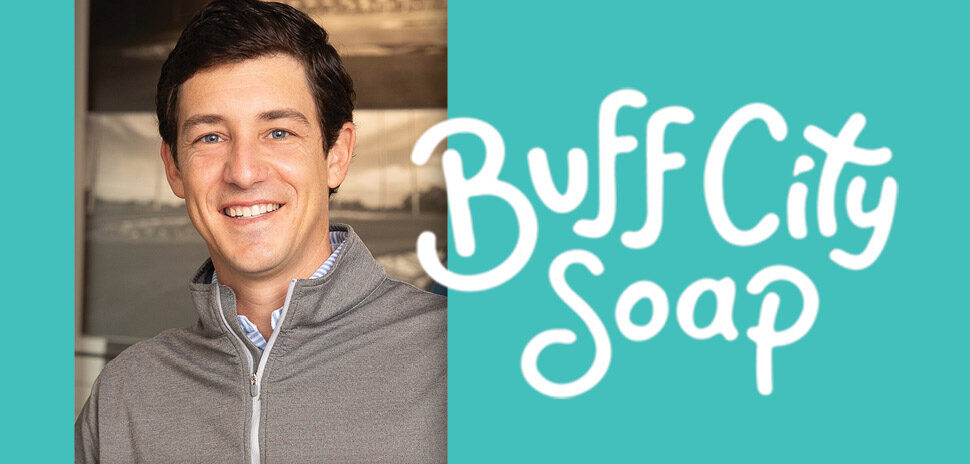Editor’s Note: Since this article was published in the Summer 2019 edition of the Dallas-Fort Worth Real Estate Review, developer Howard Hughes announced that it is moving the company headquarters from Dallas to its Woodlands regional office in Houston as part of a company transformation and executive reorganization. According to the Allen Economic Development Corp., Howard Hughes has listed Monarch City, which received zoning approval in June, as a non-core asset of the company.
It’s hard to say what trends will dominate mixed-use development 100 years from today, but Monarch City, Howard Hughes Corp.’s soon-to-break-ground development in Allen, is prepared.
A 261-acre greenfield site situated at the intersection of U.S. Highway 75 and State Highway 121 is slated to house the first incarnations of Monarch City. And, it’s from the earliest settlers in the area that the development derives its name.
The region that is now Allen is fed by small waterways crisscrossing the terrain. The land was fertile—pregnant with wildlife, natural grasses, and Monarch butterflies by the thousands—the settlers noted in letters back home.
Though the natural features today are largely obscured by above-grade highways and treetops, developers at Monarch City are working to again reveal the splendor and reintroduce native pollinators to the area.
Described by its tagline, “Inspired by nature; ready for tomorrow,” Monarch City is a mixed-use development created by The Howard Hughes Corp., the developer behind master-planned communities such as Circle T Ranch in Westlake and The Woodlands, north of Houston.
Jim McCaffrey, Howard Hughes’ senior vice president of development, describes the project as an example of placemaking, “creating an identity, and identities, that go beyond a single use.”
McCaffrey says Monarch City’s 20-plus acre central park will be larger than Dallas’ Klyde Warren Park and notes the impact of the park in the city’s Arts District.
“We should be doing something that, in 100 years, is going to be here and is going to be great.”
Scott Polikov
“Klyde Warren Park has become one of the most desirable places in Dallas and has had a positive impact on the surrounding city blocks because of the way it has successfully integrated an active central gathering space into an urban area,” he says. “Monarch City provides us the opportunity to create a similarly successful destination.”
While the park is at the heart of Monarch City’s placemaking efforts, the development’s reach goes beyond outdoor spaces.
McCaffrey says the community is expected to support some 20,000 onsite office jobs and provide roughly $300 million to $500 million in tax revenue to the city of Allen over the next 30 years.
Overall, developers say they estimate around 10 million square feet of space will be developed across roughly 50 buildings. When broken down, the vision for Monarch City estimates 5 to 6 million square feet of office, more than 3,000 residential units, 300,000 to 400,000 square feet of retail, and two hotels.
Months of work paid off in June when developers were granted form-based zoning on the project. The zoning gives developers significant flexibility within a specific framework for design, allowing the community to evolve alongside the needs of its users.
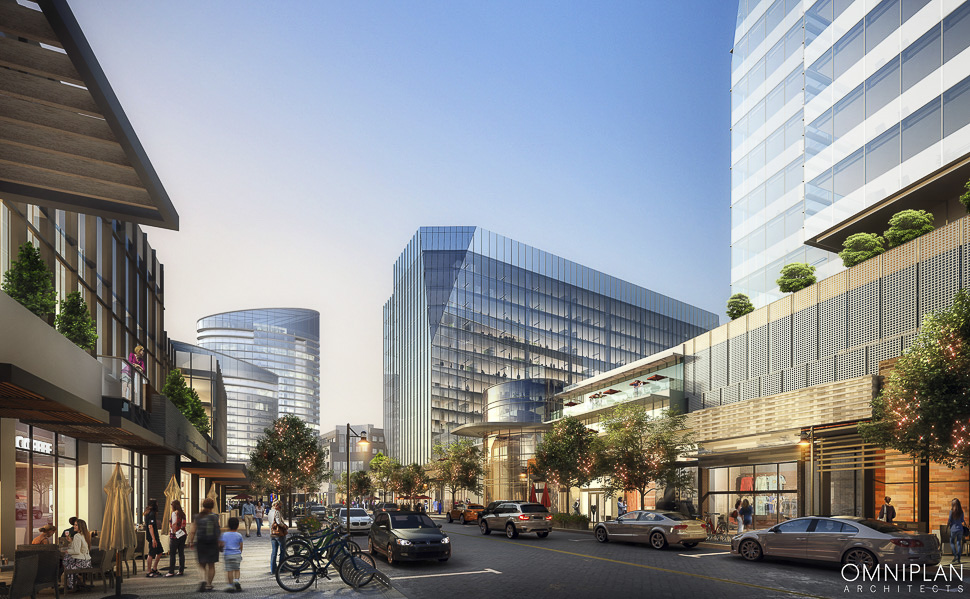
[Rendering: Courtesy Omniplan Architects]
Scott Polikov, CEO of Gateway Planning and a consultant on the project, says the code will allow Monarch City to evolve and meet the changing needs of the public far into the future.
“We should be doing something that, in 100 years, is going to be here and is going to be great,” Polikov says. “As the project, the community, and the neighborhoods evolve, it will always be thriving, and it will maintain the original vision of what it’s going to be. And that’s the world of form-based code.”
Prairie to parks: Allen’s grassy roots
Wild mustang horses, buffalo, grizzly bears, and Monarch butterflies by the thousands once dominated the landscape that makes up present day Allen in Collin County. And, early settlers took note of the region’s lush landscape, writing home to their family members about the lively ecology they had found there.
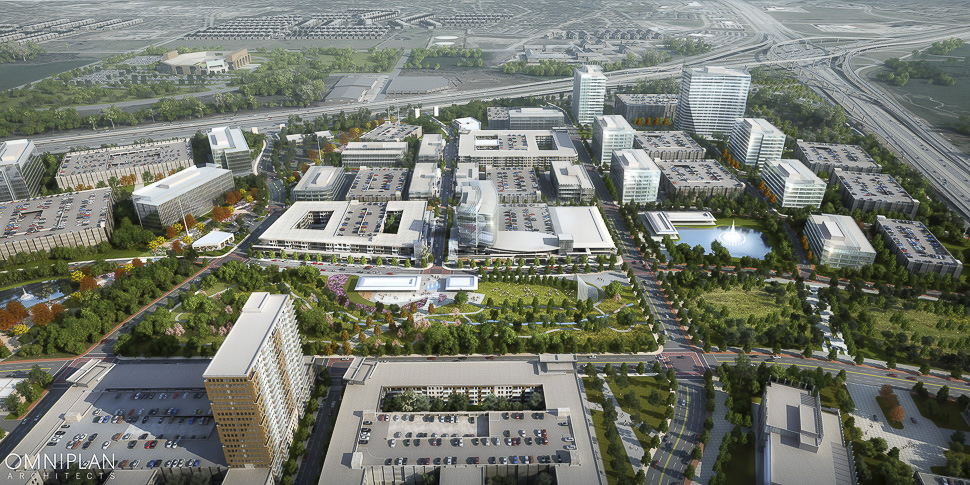
[Rendering: Courtesy Omniplan Architects]
Tom Keener, cultural arts manager for the Allen Public Library, says the region falls in Texas’ Blackland Prairies, an area known for its fertile black soil. Because of the soil, settlers noted a unique phenomenon.
“When the pioneers came to Allen, their children would get lost in the grasses like you would get lost in the forest.” he says.
The grasses, he says, contributed to the area’s fertility, thanks to the gigantic flocks of Monarch butterflies that passed through the area during their migration from Canada to Mexico.
MONARCH CITY BY THE NUMBERS
Total Program: 10 million square feet
Office: 5-6 million square feet
Retail: 300,000-400,000 square feet
Residential Units: 3,000-4,000
Hotel Rooms: 300-600
Central Park: 20+ acres
Additional Pocket Parks: 5
“The soils were perfect because of the grasses and the role of the butterflies in pollinating,” Keener says. “The waste of the buffaloes would also help put nutrients in the soil.”
Keener, who has consulted on past developments in Allen, says he saw Howard Hughes’ developers’ eyes light up when he mentioned the butterfly migration.
“I always give people the natural history of the area,” Keener says. “And usually that’s when people’s eyes start glazing over. But these people were getting their pencils out and writing everything down.”
Mark Bulmash, senior vice president of development of Howard Hughes, says the development intends to reinstate green spaces and pollinator-friendly vegetation to attract Monarch butterflies and other native species, back to the area.
“As the area was settled, many of these [natural] features were removed to accommodate farmland and the establishment of civilization,” Bulmash says. “Much of the flora that formerly supported migratory paths spanning from Canada to Mexico has been destroyed over the past decades.”
Howard Hughes worked with Dallas-based architecture firm Omniplan to provide vision-casting and site-planning for Monarch City.
Tipton Housewright, principal at Omniplan, says, “the plan is to create a walkable urban environment that is based on a very, very robust green space and parks plan. That’s just sort of unprecedented in North Texas.”
Dominating the center of the development is a central park, which Howard Hughes’ Jim McCaffrey says will contribute to the community’s walkability.
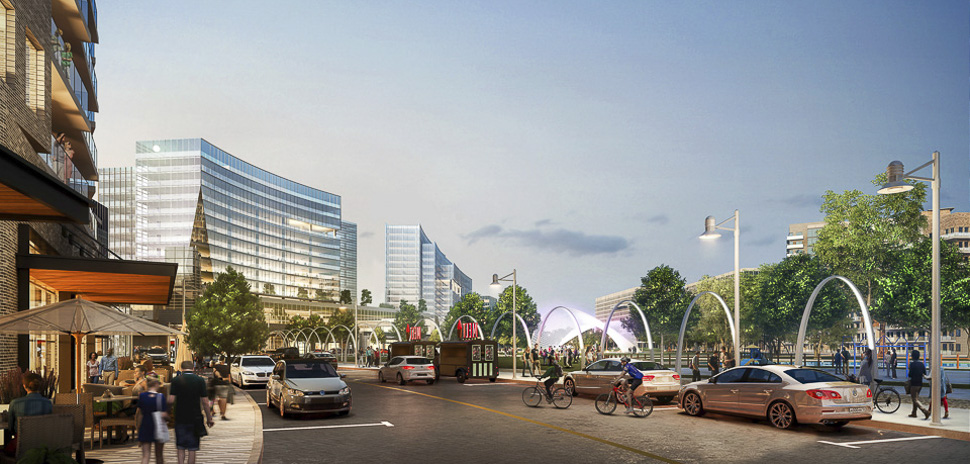
[Rendering: Courtesy Omniplan Architects]
“People aren’t looking for a concrete jungle,” McCaffrey says.
“With the scale of Monarch City, we can create various areas of density accentuated by pocket parks and a spacious 20-acre central park, which will serve as a public gathering space. By providing this range of spaces and amenities, we can enhance the quality of life for office tenants, residents, and visitors … create true value and great placemaking—profitability follows from there and will endure the test of time.”
From humble beginnings
More than a century after pioneers first arrived in Allen, the Belz Outlet Mall was built on some 43 acres near the intersection of U.S. Highway 75 and State Highway 121, then a two-lane road used mostly by farmers living in the rural areas that now make up Frisco, Allen, and surrounding communities. The mall was only open from 1983 to 1987.
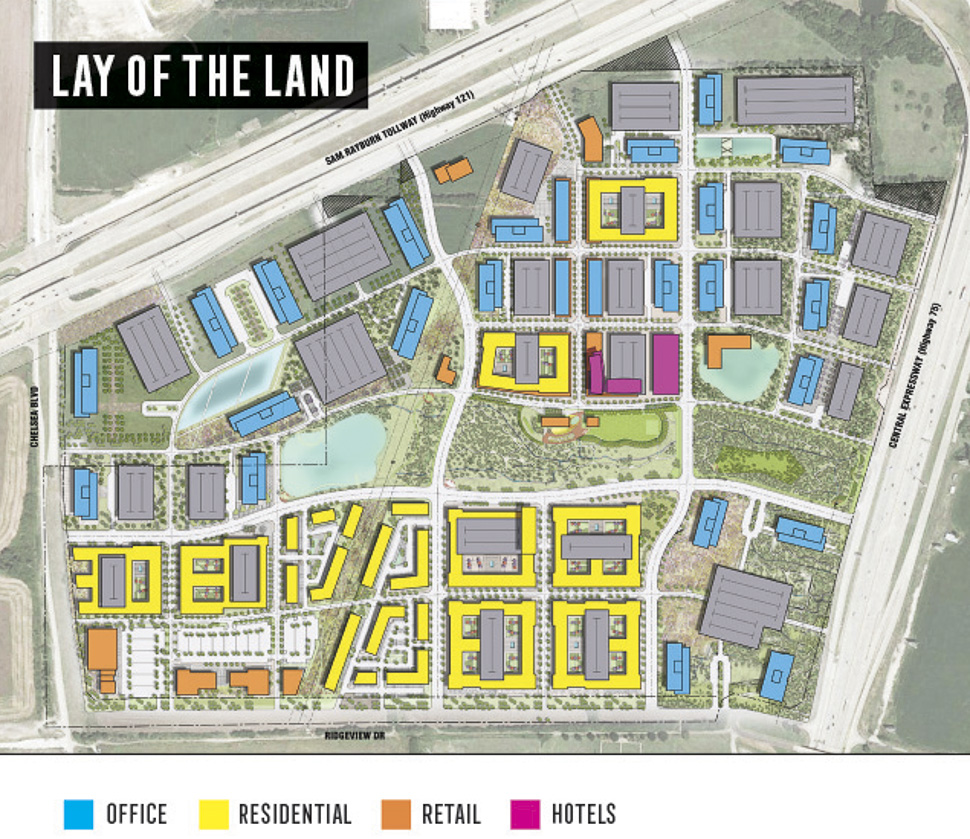
After its closure, the outlet mall was acquired by General Growth Properties (GGP), a purveyor of malls across the United States. When GGP filed for Chapter 11 bankruptcy protection in 2009, Dallas-based The Howard Hughes Corp. was spun off from GGP, and it inherited the land.
The Belz Outlet Mall was demolished in 2010, leaving behind one of North Texas’ largest undeveloped parcels of land at a major intersection.
“As the area is being built out, opportunities are becoming increasingly rare,” says Howard Hughes’ Mark Bulmash. “Monarch City has the unique opportunity to support the next wave of corporate relocations. We also have the advantage of such a large undeveloped parcel in which to establish a new walkable urbanism, which will redefine an area that people have previously just driven through, as opposed to driven to.”
Allen mayor Steve Terrell agrees with Bulmash, citing congestion and urban sprawl in areas such as Dallas and Plano as the impetus for Allen’s future success as a major employment hub.
“People aren’t looking for a concrete jungle.”
Jim McCaffrey
“The Dallas North Tollway and the 121 corridor out in that area—it keeps getting more and more congested,” Terrell says. “It just pushes more of the economic development in this direction, so that’s a big plus.”
The City of Allen is working to build out what its calls its “121 Corridor,” a largely undeveloped stretch of highway in Allen that connects the city to Dallas Fort Worth International Airport. The city’s strategic growth plan outlines intentions for the corridor.
“The primary focus for this area is the development of high-quality office, tech, and light industrial employment centers along the Highway 121 corridor,” the plan states. “The S.H. 121 corridor from the western city limits to U.S. 75 should be developed as quality employment centers to include high- and low-rise offices, selected high quality technology and light industrial uses, and campus-type corporate development, similar to what has been developed in some areas along the U.S. 75 corridor.”
The strategic plan goes on to state single-family development is discouraged, instead favoring dense multifamily residential areas that include structured parking and are integrated into mixed-use projects.
Marc Kurbansade, director of community development in Allen, says Monarch City aims to do what the Belz Factory Outlet could not: namely, to activate the 121 corridor in Allen and draw other developments and employment centers to the area.
“We expect that this will serve as a catalyst along the 121 corridor to start to attract other employment areas,” he says. “It starts to create a place, and it starts to create something that people can identify with right now.”

[Rendering: Courtesy Omniplan Architects]
Building for the future
Monarch City is unique not only in its size, but also in its flexibility. In order to create what its developers are calling a “100-year city,” they had to apply for—and get approved—form-based zoning, a measure that allows flexibility in buildout within specific margins.
The City of Allen’s Marc Kurbansade says form-based zoning code “is meant to develop a property that has its focus on just that—form—with the idea that buildings are going to outlive uses.”
Monarch City is unique in that it does not currently have a rigid site plan. And because there’s no site plan, developers have the flexibility to build for the needs of its stakeholders. Form-based zoning allows them to do that while still meeting certain requirements laid out by the city.
The zoning—which was approved by Allen City Council in June 2019—consists of a kit of parts that give developers significant flexibility as they build out the full 261 acres in multiple phases in the coming years, Kurbansade says.
The kit specifies requirements that the developer must meet, including maximum and minimum density and height, specific architectural styles, certain streetscape widths, and more.
ZONING TIMELINE
2010
November: Howard Hughes acquires the Monarch City site from General Growth Properties.
2018
May: Howard Hughes publicly announces development plans.
September: Howard Hughes files a zoning application.
September: The Technical Review Committee meets for the first time.
November: The Allen City Council holds a work session on form-based codes.
2019
January 8: The second Technical Review Committee reviews the development’s potential impact on stakeholders including the school district, utility companies, and other service providers.
February 12: Allen City Council holds a public work session on Monarch City’s proposed use of form-based codes.
February 19: The Planning & Zoning Commission holds a public work session on form-based codes.
May 23: Allen City Council and the Planning & Zoning Commission together host a public workshop on form-based zoning codes.
June 4: In a public hearing, Allen’s Planning & Zoning Commission recommends approval of the proposed zoning.
June 25: Allen City Council approves form-based zoning in Monarch City.
“You’re building an area that has attention paid to detail, attention paid to open spaces, attention paid to the form of development, because those are timeless,” he says.
Unlike the typical zoning process, which takes six to eight months and can hinder a developer’s timeline, form-based zoning eliminates red tape and expedites a development’s time to market. But significant time was spent on the front end educating the public and city council and garnering buy-in, Kurbansade says.
Howard Hughes’ Mark Bulmash says the form-based zoning doesn’t solely affect the development in the short term: It also will give developers the flexibility to make changes in the future as expectations of mixed-use communities evolve alongside technologies.
“Part of developing for the long-term means understanding that technology is advancing at an exponential rate, and we must plan today for how we can accommodate innovative technologies in the future,” Bulmash says. “As just one example, we know that 5G technology is fast arriving, so we are planning for the extra towers that will be required and designing buildings with the infrastructure to take full advantage of this exciting new innovation.”
Kurbansade says he also foresees the form-based zoning created for Monarch City influencing other developments along the 121 Corridor.
“I imagine this will provide some context for developers to consider in their zoning entitlements,” he says. “I think that from the perspective of planning and zoning, the zoning implementation for Monarch City may provide a template of sorts for those developers.”
Planning a ‘100-year city’
Technological innovations beyond imagination are sure to shape the future. While it’s impossible to imagine what the year 2119 will hold, developers aim to meet the needs of future residents and commercial tenants in a mixed-use development. That’s where form-based zoning comes in.
Howard Hughes’ Mark Bulmash says developing with a plan for the future begins with understanding the exponential rate at which technology evolves and leaving room for innovation.
“We must establish an inherent flexibility within our process—the same idea behind our form-based zoning—so that we can provide our community members with the most effective and best lifestyle experience,” Bulmash says.
Now, this means designing the buildings in Monarch City with 5G capability. In a future less reliant on cars, it could mean repurposing parking garages into commercial buildings—a possibility that developers already are accounting for.
Creating a lasting development goes beyond creating a plan for future innovation. Jim McCaffrey, of Howard Hughes, says investing in environmental-conservation measures also creates a long-term impact for the development. “Energy and water conservation are crucial for our environment and are increasingly an obvious choice for cost savings as well,” McCaffrey says. “We’re getting smarter as an industry about the regional impacts of stormwater management and how to engineer our systems in a more responsible and effective way.”
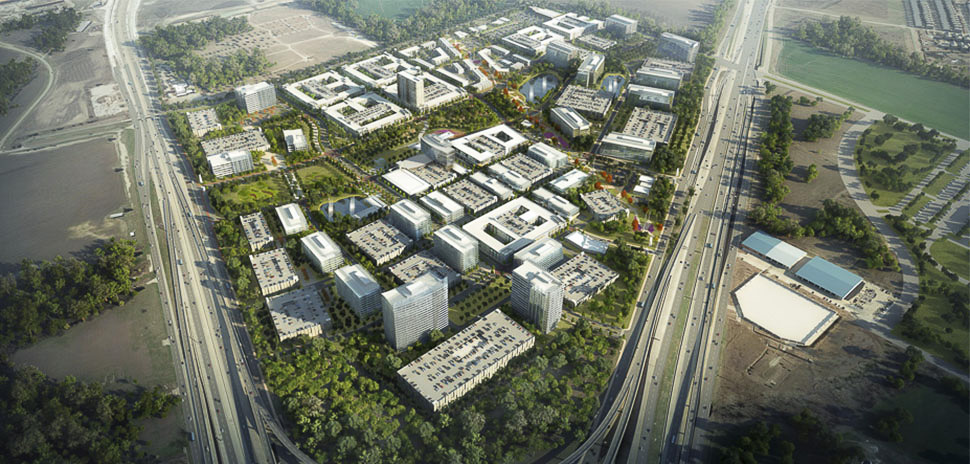
[Rendering: Courtesy Omniplan Architects]
“Countless design decisions add up to making a timeless place: the context within the surroundings, infrastructure backbone, form, function, structure, technology, materials, etcetera. But above all of these elements is a great team,” he adds.
Scott Polikov, CEO of Gateway Planning and a consultant on Monarch City, says he coined the phrase “100-Year City.” To him, sustainability is all about making responsible choices today for the people of tomorrow.
“We’re taking responsibility for the outcome 100 years from now,” Polikov says. “At the end of the day, the mayor and city council are making decisions on what is going to be, and Howard Hughes is making decisions on what it’s going to be.”
Read the digital edition of Dallas Innovates’ sister publication, the Real Estate Review, on Issuu. Sign up for the digital alert here.
![]()
Get on the list.
Dallas Innovates, every day.
Sign up to keep your eye on what’s new and next in Dallas-Fort Worth, every day.

